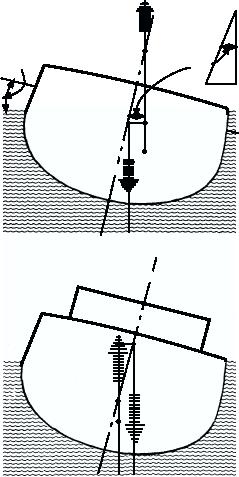
The INITIAL position of the metacenter is most
The ship's METACENTRIC HEIGHT (GM) is not
useful in the study of stability, because it provides a
only a measure of the ship's RIGHTING ARM (GZ)
reference point when the ship is upright and most
but is also an indication of whether the ship is stable or
stable. In our discussion we will refer to initial position
unstable. If M is above G, the metacentric height is
of M. The distance from the center of buoyancy (B) to
positive, the moments which develop when the ship is
the metacenter (M) when the ship is on even keel is the
inclined are RIGHTING MOMENTS, and the ship is
METACENTRIC RADIUS.
stable, as shown in view A of figure 12-23. But if M is
below G, the metacentric height is negative, the
Metacentric Height
moments that develop are UPSETTING MOMENTS,
and the ship is unstable, as shown in view B of
The distance from the center of gravity (G) to the
figure 12-23.
metacenter is known as the ship's METACENTRIC
HEIGHT (GM). Figure 12-23, view A, shows a ship
Influence of Metacentric Height
heeled through a small angle (the angle is exaggerated
in the drawing), establishing a metacenter at M. The
If the metacentric height (GM) of a ship is large,
ship's righting arm is GZ, which is one side of the
the righting arms that develop, at small angles of heel,
triangle GZM. In this triangle GZM, the angle of heel is
will be large. Such a ship is "stiff" and will resist roll.
at M. The side GM is perpendicular to the waterline at
However, if the metacentric height of a ship is small,
even keel, and ZM is perpendicular to the waterline
the righting arms that develop will be small. Such a
when the ship is inclined.
ship is tender and will roll slowly.
M
In ships, large GM and large righting arms are
desirable for resistance to damage. However, a
M
ANGLE
OF
smaller GM is sometimes desirable for a slow, easy
HEEL
ANGLE OF HEEL
roll that allows for more accurate gunfire; therefore,
Z
G
the GM value for a naval ship is the result of
compromise.
Z
G
B
Inclining Experiment
C
L
The ship designer uses calculations to determine
the vertical position of the center of gravity. From
available plans and data, the various items that go to
A
make up the ship and its load are tabulated. The ship
can be considered as consisting of the various parts of
C
L
the structure, machinery, and equipment. The load is
comprised of fuel, oil, water, ammunition, and sundry
stores aboard.
G
Z
Although the position of the center of gravity as
estimated by calculation is sufficient for design
M
purposes, an accurate determination is required to
B
establish the overall stability of the ship when it is
operating. Therefore, an inclining experiment is
performed to obtain accurately the vertical height of
B
the center of gravity above the keel (KG) when the ship
DCf1223
Figure 12-23. A. Stable condition, G is below M; B. Unstable
is completed. An inclining experiment consists of
condition, G is above M.
moving one or more large weights across the ship and
measuring the angle of list produced. This angle of list
It is evident that for any given angle of heel, there
usually does not exceed 2. The ship should be in the
will be a definite relationship between GM and GZ
best possible condition for the inclining. The naval
because GZ = GM sin θ. Thus GM acts as a measure of
shipyard or building yard at which the inclining
GZ, the righting arm.
experiment is to be performed issues a memorandum to
12-10

